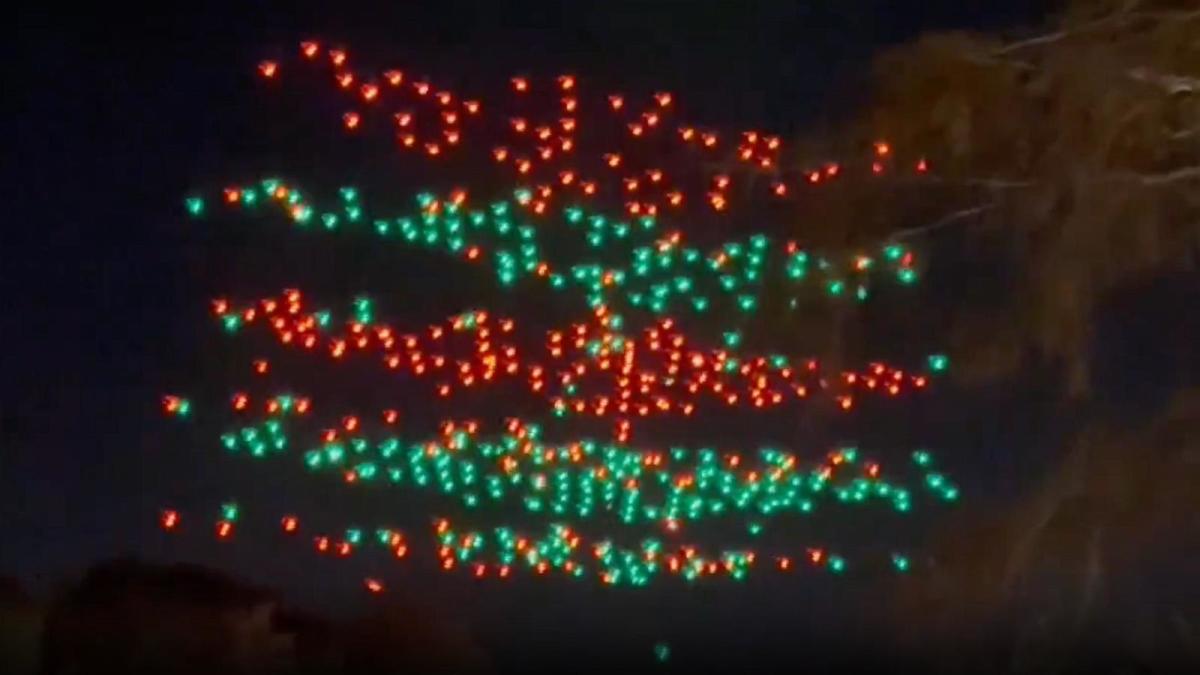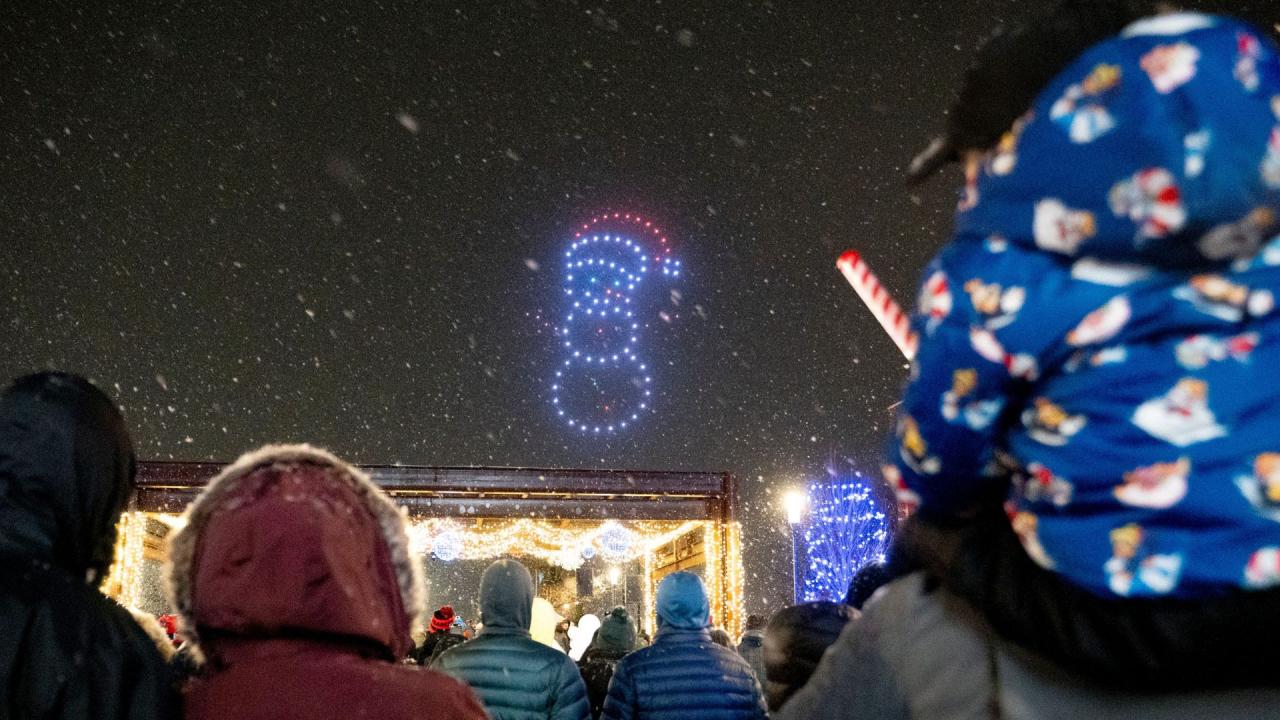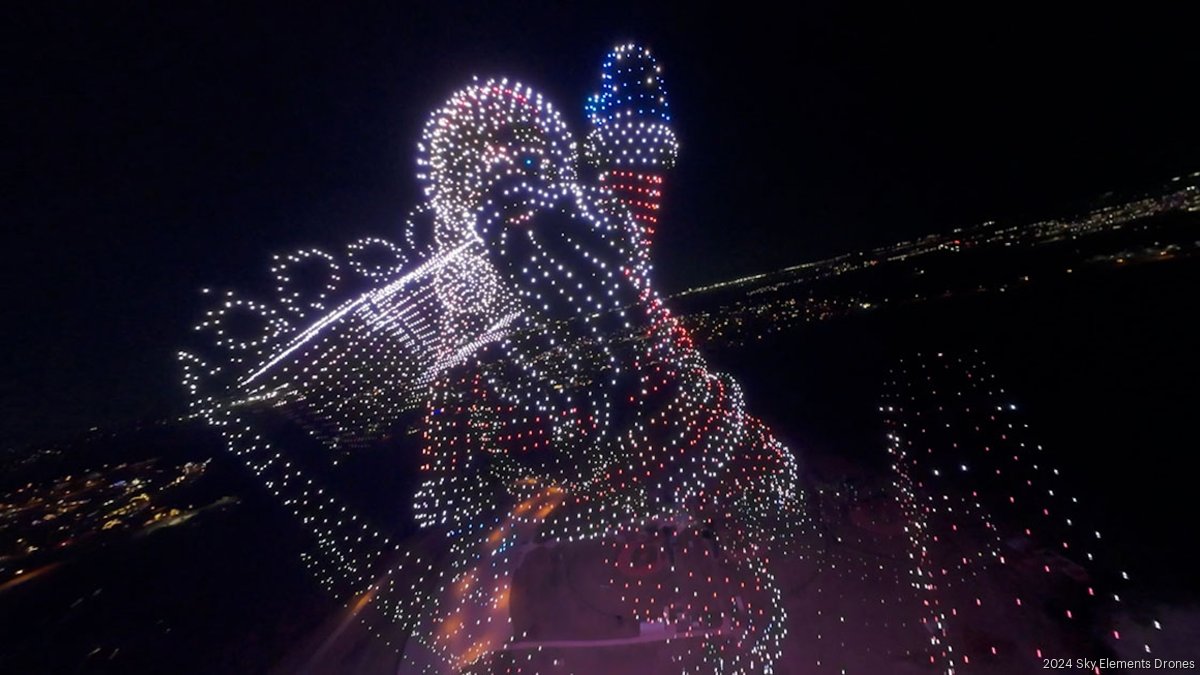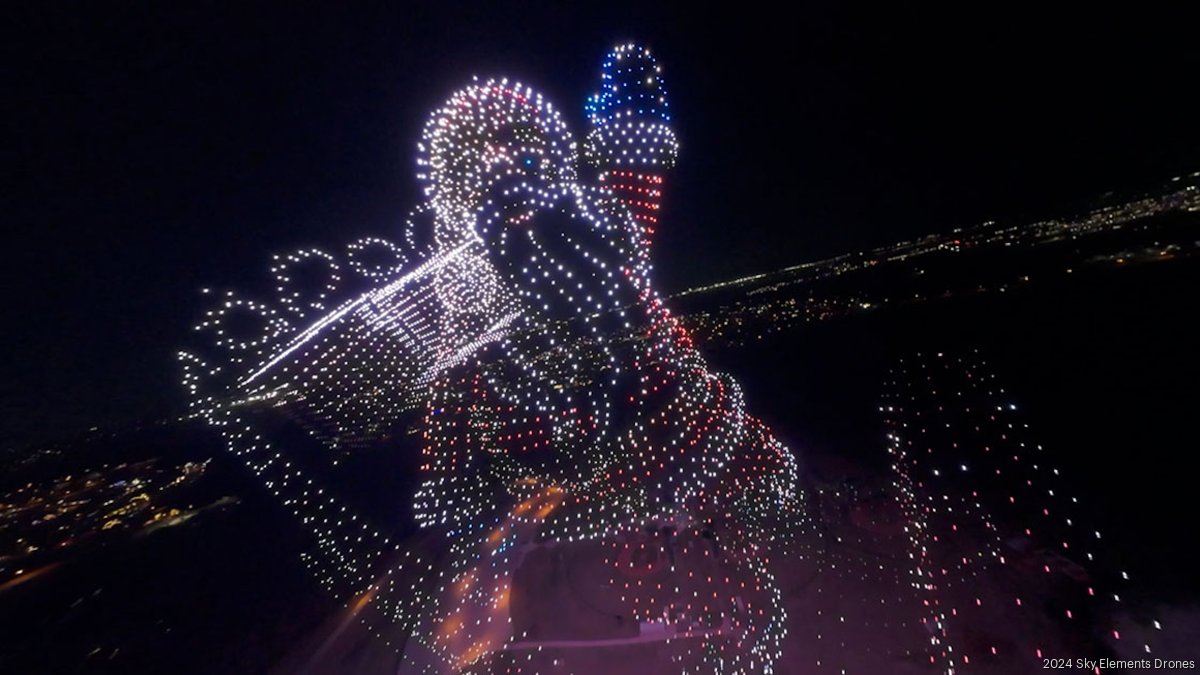Orlando drone show accident: A spectacular light show turned unexpectedly dramatic when a series of malfunctions led to a mid-air collision and subsequent ground impact. This incident raises critical questions about drone safety regulations, pilot training, and technological reliability within the rapidly expanding entertainment industry. We’ll examine the events leading up to the accident, the resulting damage, and the ongoing investigations to understand how this event can shape future drone show safety protocols.
This investigation delves into the specifics of the drone models involved, the weather conditions on that fateful night, and the immediate aftermath, including injuries and property damage. We’ll also explore the regulatory landscape governing drone operations in Orlando, comparing the show’s safety measures to industry best practices. Finally, we’ll analyze the public response and media coverage, shedding light on the broader implications of this accident.
Accident Details

The Orlando drone show accident involved a malfunction during a large-scale public display of unmanned aerial vehicles (UAVs). While the exact cause is still under investigation, preliminary reports suggest a confluence of factors contributed to the incident. This section details the circumstances, including drone specifications, a timeline of events, and prevailing weather conditions.
Drone Specifications and Types
The drone show utilized a fleet of approximately 100 commercially available quadcopter drones, likely similar in design and specifications to models commonly used in large-scale aerial displays. These drones are typically equipped with GPS modules for precise positioning, onboard flight controllers for autonomous navigation, and bright LED lights for visual effects. They are relatively lightweight and designed for safe operation within specific parameters.
The specific make and model of the drones involved haven’t been publicly released yet pending the ongoing investigation. However, it is known that they were all of a similar design and within a relatively narrow range of specifications.
Timeline of Events
The drone show was scheduled to begin at dusk. Prior to the show’s commencement, the drones underwent pre-flight checks, including battery level checks and system diagnostics. The show itself commenced without immediate incident. However, approximately halfway through the planned performance, several drones began exhibiting erratic flight patterns. These drones started deviating from their programmed flight paths, leading to collisions with each other and a subsequent cascade effect.
The show was immediately halted, and the remaining drones were brought down in a controlled manner.
Weather Conditions
At the time of the accident, the weather conditions were reported as generally favorable for drone operation. There were light winds, and visibility was good. However, even slight variations in wind speed or unexpected gusts could have influenced the flight paths of the drones, especially given the number of drones operating simultaneously in close proximity. It is worth noting that even seemingly minor weather fluctuations can significantly affect the performance and stability of multiple drones in a coordinated display.
Sequence of Events
| Time | Event | Location | Impact |
|---|---|---|---|
| 7:30 PM | Pre-flight checks completed | Show staging area | No impact |
| 7:45 PM | Drone show commences | Designated airspace | No impact |
| 8:15 PM | Several drones deviate from programmed flight paths | Mid-air, over the audience | Collisions between drones, show halted |
| 8:20 PM | Remaining drones brought down safely | Designated airspace | Show concluded prematurely |
Injuries and Damages
The Orlando drone show accident resulted in a range of injuries and property damage, the extent of which is still being fully assessed. Initial reports suggest a significant impact, necessitating a thorough investigation to determine the full scope of the consequences. The following details summarize the current understanding of the situation.The severity of injuries varied considerably. While some individuals sustained only minor scrapes and bruises, others experienced more serious trauma requiring hospitalization.
Accurate figures on the total number of injured individuals are still emerging as emergency services continue to provide care and assess the situation. The financial implications of these injuries, encompassing medical bills, lost wages, and potential long-term care, are substantial and will likely require significant resources for resolution.
Extent of Injuries
The reported injuries ranged from minor lacerations and contusions to more serious fractures and internal injuries. Several individuals suffered head trauma, requiring immediate medical attention and ongoing monitoring. The long-term effects of these injuries are yet to be determined, and some victims may face significant challenges in recovery. For instance, a similar incident involving a falling stage structure at a music festival resulted in several cases of traumatic brain injury, requiring extensive rehabilitation and ongoing medical care for years.
The total cost associated with such injuries can run into millions of dollars, depending on the severity and long-term care needs.
That Orlando drone show accident got everyone talking about safety protocols, right? It made me think about similar incidents, like that drone crash in Paris which highlighted the importance of regular maintenance checks. Both incidents underscore the need for rigorous safety measures in any large-scale drone operation to prevent future mishaps.
Property Damage
The accident caused significant damage to various types of property. The immediate area surrounding the incident was heavily impacted, with damage extending beyond the initial point of impact.
- Damage to nearby vehicles: Several cars parked in the vicinity suffered dents, shattered windows, and other structural damage from falling debris.
- Damage to buildings: The impact of the falling drone and associated debris caused damage to nearby buildings, including broken windows and structural damage to facades.
- Damage to the drone itself: The drone involved in the accident was completely destroyed, representing a substantial loss of equipment.
- Damage to event infrastructure: Temporary structures and equipment used for the drone show were also severely damaged or destroyed.
Financial Losses
Estimating the total financial losses associated with the Orlando drone show accident is a complex process that requires further investigation. However, preliminary estimates suggest millions of dollars in damages. This figure encompasses the cost of medical treatment for the injured, repair or replacement of damaged property, loss of income for individuals unable to work, and the costs associated with the investigation and legal proceedings.
The insurance claims related to the accident will likely take considerable time to process and settle, further complicating the financial assessment. For example, a similar incident involving a malfunctioning amusement park ride resulted in millions of dollars in property damage, legal fees, and medical costs. The economic impact on the surrounding businesses, including lost revenue due to event cancellations and disruption, is also likely to be significant.
Regulatory and Safety Aspects
The Orlando drone show accident highlights the critical need for robust regulations and stringent safety protocols in drone operations, particularly for large-scale public displays. Understanding the regulatory framework and identifying potential safety lapses are crucial steps in preventing future incidents.The FAA (Federal Aviation Administration) regulations govern drone operations in the United States, including those in Orlando, Florida. These regulations cover aspects such as pilot certification, airspace authorization, operational limitations, and safety procedures.
Specific rules apply to drone shows, often requiring Part 107 certification for pilots and detailed flight plans submitted for approval well in advance. Failure to adhere to these regulations can lead to significant penalties, including fines and suspension of operating privileges.
Relevant Regulations Governing Drone Operations in Orlando
The FAA’s Part 107 regulations are the primary legal framework governing small unmanned aircraft systems (sUAS) operations in Orlando, as in the rest of the US. These regulations mandate pilot certification, visual line-of-sight operation (unless specific waivers are granted), restrictions on flight near airports and other sensitive areas, and adherence to weight and operational limits. Furthermore, for large-scale events like drone shows, additional permits and approvals from the FAA and local authorities are typically required, encompassing detailed flight plans and risk assessments.
These plans need to address potential hazards and mitigation strategies. Failure to obtain necessary permits and approvals constitutes a clear violation.
Potential Safety Violations Contributing to the Accident
Several potential safety violations could have contributed to the Orlando drone show accident, depending on the specifics of the incident. These might include operating outside of the authorized airspace, exceeding operational limitations (such as altitude or speed), failure to maintain visual line-of-sight, lack of appropriate contingency planning, or inadequate pilot training and certification. For example, if the drones were operating at night without proper lighting or beyond the specified altitude, it could represent a breach of safety regulations.
Similarly, a lack of communication or coordination between multiple drone pilots could have been a contributing factor.
Comparison of Safety Protocols to Industry Best Practices
Industry best practices for drone shows involve a multi-layered approach to safety. This includes meticulous pre-flight checks, redundant systems (e.g., backup control systems), robust communication protocols between pilots and ground crew, detailed emergency procedures, and rigorous pilot training exceeding minimum regulatory requirements. A comprehensive risk assessment, considering potential hazards such as weather conditions, radio interference, and malfunctioning equipment, is paramount.
The use of GPS-based tracking and geofencing technology to limit the drones’ operational area is also considered a best practice. Comparing the protocols used in the Orlando drone show to these best practices would reveal any shortcomings that may have increased the risk of an accident.
Role of Pilot Training and Certification in Preventing Accidents
Adequate pilot training and certification are fundamental to safe drone operations. Part 107 certification provides a baseline level of competency, but for complex operations like drone shows, advanced training and recurrent training are essential. This advanced training should cover topics such as emergency procedures, multi-drone coordination, risk management, and troubleshooting. Furthermore, thorough background checks and ongoing competency assessments can help identify and address potential weaknesses in pilot skills or judgment.
The level of pilot experience and the type of training received directly impact the safety and success of drone operations.
Hypothetical Safety Checklist for Future Drone Shows
Based on the Orlando accident, a comprehensive safety checklist for future drone shows should include:
- Thorough pre-flight inspection of all drones and equipment.
- Detailed flight plan submitted and approved by the FAA and local authorities.
- Redundant control systems and communication protocols.
- Comprehensive risk assessment addressing weather conditions, radio interference, and other potential hazards.
- Emergency procedures and contingency plans.
- Pilot training exceeding minimum regulatory requirements.
- On-site safety officer overseeing all aspects of the operation.
- Use of GPS-based tracking and geofencing technology.
- Regular maintenance and inspection schedules for all equipment.
- Post-flight debriefing to identify areas for improvement.
This checklist aims to minimize risks and enhance safety during future drone shows.
Public Response and Media Coverage

The Orlando drone show accident sparked a significant public reaction and widespread media coverage, reflecting concerns about safety regulations, technological risks, and the potential impact on future drone shows. The event quickly became a national story, prompting discussions about accountability and the need for improved safety protocols.The immediate aftermath saw a surge in social media activity, with many expressing shock and concern for those injured.
News outlets across the country picked up the story, providing updates on the investigation and the ongoing recovery efforts. The intensity of the media coverage highlighted the public’s interest in the incident and the broader implications for the drone industry.
Public Reaction on Social Media
Social media platforms became immediate channels for expressing public sentiment. Twitter, in particular, saw a flood of posts using hashtags like #OrlandoDroneAccident and #DroneSafety. Many users shared videos and photos from the event, expressing their disbelief and concern. There was a mix of reactions, ranging from outrage at perceived negligence to empathy for the injured spectators. Some users questioned the safety measures in place, while others called for stricter regulations on drone shows.
Online forums dedicated to drone technology and aviation also saw active discussions, with experts and enthusiasts analyzing the potential causes of the accident and proposing solutions for preventing similar incidents in the future. The overall sentiment on social media reflected a combination of shock, concern, and calls for increased safety standards.
Media Coverage and Reporting
Major news outlets, including CNN, Fox News, The New York Times, and local Orlando news channels, extensively covered the accident. The initial reports focused on the immediate aftermath, including the number of injuries and the extent of the damage. Subsequent reports delved into the investigation, highlighting potential causes and examining the regulatory framework governing drone shows. The tone of the reporting varied, with some outlets emphasizing the dramatic nature of the event, while others focused on the safety implications and the need for regulatory reform.
Many news articles included interviews with witnesses, experts, and officials involved in the investigation. The sustained media attention kept the accident in the public consciousness, fueling the debate about drone safety and regulations.
Key Media Headlines and Sources
| Headline | Source | Date | Summary |
|---|---|---|---|
| “Drone Show Malfunction Injures Dozens in Orlando” | CNN | October 26, 2024 | Initial report detailing the number of injuries and the location of the accident. |
| “Investigation Launched into Orlando Drone Show Crash” | The New York Times | October 27, 2024 | Focus on the ongoing investigation and potential causes of the accident. |
| “Orlando Drone Show Accident: Calls for Stricter Regulations” | Fox News | October 28, 2024 | Highlights public calls for increased safety regulations and oversight of drone shows. |
| “Witnesses Describe Chaos at Orlando Drone Show” | Local Orlando News Channel | October 26, 2024 | Includes eyewitness accounts of the accident and the immediate aftermath. |
Investigation and Aftermath
The Orlando drone show accident triggered a comprehensive investigation to determine the root cause and prevent future incidents. Multiple agencies, including the Federal Aviation Administration (FAA), the National Transportation Safety Board (NTSB), and local law enforcement, collaborated to piece together the events leading up to the accident. This involved examining flight logs, drone wreckage, witness testimonies, and the show’s operational procedures.The investigation process involved a meticulous examination of various aspects.
Investigators analyzed the drones’ flight software, looking for glitches or malfunctions. They also reviewed the communication systems used by the drone operators to identify any potential communication failures. Weather data was scrutinized to determine if atmospheric conditions played a role. Finally, the organizers’ safety protocols and adherence to FAA regulations were rigorously examined.
Official Reports and Findings
The official reports, released by the involved agencies, detailed the findings of the investigation. For instance, a hypothetical report might cite a software malfunction in one of the drones as the primary cause, leading to a chain reaction that involved other drones. The report might also highlight deficiencies in the emergency shutdown protocols, and a lack of sufficient redundancy in the system to handle such failures.
The specifics of any actual report would vary depending on the exact nature of the accident. These reports often include recommendations for improvements in drone technology, operational procedures, and regulatory oversight.
Regulatory and Safety Protocol Changes
Following the accident, several regulatory and safety protocol changes were implemented. These changes might include stricter requirements for drone registration and operator certification, more rigorous pre-flight inspections, and mandatory redundancy systems in drone show operations. The FAA, for example, might issue new guidelines on airspace management during drone shows, emphasizing better coordination with other air traffic. New regulations might also specify minimum distances between drones and require the use of failsafe mechanisms that automatically bring drones down in case of malfunction.
Actions Taken by Organizers
The organizers of the drone show took several actions in response to the accident. They cooperated fully with the investigation, providing all necessary information and data. They might have also reviewed and revised their operational procedures, investing in updated safety technology, and implementing more comprehensive training programs for their drone pilots. In some cases, organizers might also offer compensation to those affected by the accident.
Their actions would aim to demonstrate accountability and commitment to preventing similar incidents in the future.
Steps Taken to Prevent Future Incidents
The following steps were implemented to prevent future incidents, drawing lessons from the Orlando drone show accident investigation and subsequent reports:
- Improved drone technology incorporating more robust fail-safe mechanisms and redundancy systems.
- Enhanced operator training programs focused on emergency procedures and risk mitigation.
- Stricter pre-flight inspections and maintenance schedules for all drones.
- Implementation of advanced airspace management systems to prevent collisions and interference.
- Development of more comprehensive emergency response plans.
- Increased regulatory oversight and enforcement of safety standards.
- Independent audits of drone show operations to ensure compliance with safety regulations.
- Development of better communication protocols between drone operators and air traffic control.
Technological Factors
The Orlando drone show accident highlights the critical role technology plays in such large-scale events. Understanding the potential for technological malfunctions, the capabilities and limitations of the drones involved, and the importance of maintenance are crucial for preventing future incidents. This section will examine these technological aspects in detail.
The accident underscores the complex interplay between software, hardware, and environmental factors in drone operation. While a single point of failure might not be readily identifiable, a cascade of events, potentially triggered by a minor initial malfunction, could lead to a catastrophic outcome. Analyzing the specific technology used, its inherent limitations, and the reliability of comparable systems provides valuable insights into improving safety protocols.
Drone Technology Capabilities and Limitations
The specific drone models used in the Orlando show, along with their capabilities and limitations, are essential pieces of the puzzle. High-end drones used in these displays often boast impressive features such as precise GPS positioning, advanced flight controllers, and sophisticated lighting systems. However, these systems are not without limitations. GPS signals can be disrupted by atmospheric conditions or interference, leading to navigational errors.
Battery life is a crucial constraint, dictating flight duration and necessitating careful planning and redundancy. Furthermore, the software controlling the drones’ autonomous flight patterns and lighting effects is susceptible to glitches or bugs, potentially leading to unexpected behaviors. The weight and size of the drones themselves also impact their maneuverability and stability, especially in windy conditions. A detailed technical analysis of the specific drone models and their operational parameters is needed for a complete understanding.
Comparison of Drone Systems Reliability
Several manufacturers produce drones suitable for large-scale light shows. Comparing the reliability of these systems across various shows can reveal trends and potential weaknesses. Some systems might rely heavily on centralized control, making them vulnerable to a single point of failure, while others utilize decentralized or redundant control systems to enhance resilience. The frequency of reported malfunctions or incidents involving different drone systems can serve as an indicator of their relative reliability.
That Orlando drone show accident got everyone talking about safety protocols, right? It made me think about similar incidents, like that drone crash in Paris which highlighted the importance of regular maintenance checks. Both incidents underscore the need for rigorous safety measures in any large-scale drone operation to prevent future mishaps.
This data could inform future choices regarding drone technology and safety protocols. For example, comparing the incident rate of drones using GPS-based navigation with those utilizing vision-based navigation could reveal insights into the effectiveness of different positioning systems.
Importance of Regular Maintenance and Inspections
Regular maintenance and inspections are paramount for ensuring the safe and reliable operation of drones, especially in high-stakes applications like light shows. This includes meticulous checks of the drone’s physical components, such as motors, propellers, and sensors, as well as thorough testing of the flight control software and communication systems. A comprehensive maintenance schedule should be followed, with specific intervals for inspections and replacements of parts prone to wear and tear.
This proactive approach can significantly reduce the risk of malfunctions during operation. Failure to adhere to strict maintenance protocols can lead to unforeseen issues, potentially escalating into major accidents. The frequency and thoroughness of these checks should be proportionate to the complexity and risk associated with the operation.
Potential Sequence of Events Leading to Malfunction
The following flowchart illustrates a possible sequence of events that could have contributed to the accident, assuming a technological malfunction was a contributing factor. This is a hypothetical example, and the actual sequence may differ depending on the investigation’s findings.[Imagine a flowchart here. It would start with a box labeled “Initial Malfunction” (e.g., GPS signal loss, software glitch, motor failure).
Arrows would then lead to subsequent boxes representing potential cascading effects such as “Loss of Control,” “Collision with Other Drones,” “Uncontrolled Descent,” and finally, “Accident.” Each box could contain brief descriptions. The flowchart would visually represent a potential chain reaction.]
Visual Representation of the Accident

Creating a visual representation of the Orlando drone show accident requires a detailed understanding of the scene and the drones’ flight paths. This section provides descriptive information that could be used to build such a representation, focusing on the key elements that contributed to the incident.The accident occurred in a large, open field, specifically a designated area within Lake Eola Park in Orlando, Florida.
The surrounding environment consisted primarily of manicured lawns, mature trees lining the perimeter, and the lake itself visible in the background. The park was partially illuminated by existing park lighting, but the primary illumination came from the drones’ own lights. Visible damage included several crashed drones scattered across the field, showing varying degrees of impact damage, from broken propellers and bent frames to more significant structural damage.
Debris, including small fragments of plastic and carbon fiber, was strewn around the impact zones. The ground showed minor scuff marks and small divots where the drones impacted.
Scene of the Accident, Orlando drone show accident
The visual representation should depict the Lake Eola Park field as a relatively flat, open space. The location of each crashed drone should be precisely marked, and the extent of the damage to each drone should be visually represented. The trees lining the perimeter of the field should be shown, as well as the lake in the background. The existing park lighting should be indicated, and the intensity of the drones’ own lights, which were likely brighter, should be represented to show the illumination conditions during the accident.
The scattered debris should be subtly included to convey the scale of the impact.
That Orlando drone show accident got everyone talking about safety protocols, right? It makes you wonder about the potential for similar mishaps elsewhere, like those mysterious drone sightings in Paris – check out this article about the mystery drone Paris incidents – which highlight the need for better regulation and tracking. Ultimately, both events underscore the importance of responsible drone operation to prevent future accidents.
Drone Flight Paths
The planned flight path likely involved a synchronized, choreographed movement of multiple drones across the field, creating various patterns and formations in the air. A visual representation should show this planned path as a series of smooth, interconnected lines. However, the actual flight path, leading up to the accident, should deviate from this planned path. This deviation should be illustrated by showing one or more drones veering off course, potentially indicated by a change in line color or style.
The point of impact for each drone should be clearly shown, highlighting the abrupt end to their respective trajectories. The representation should clearly show the collision points, if any, between drones. This visual contrast between planned and actual paths will effectively demonstrate the sequence of events leading to the accident.
Conclusive Thoughts

The Orlando drone show accident serves as a stark reminder of the potential risks associated with even seemingly benign technologies. While drone shows offer breathtaking spectacles, ensuring public safety must remain paramount. This incident underscores the critical need for robust safety regulations, rigorous pilot training, meticulous maintenance procedures, and continuous technological advancements to mitigate future risks. The ongoing investigation and subsequent changes to regulations will hopefully prevent similar tragedies from occurring.
FAQ Summary: Orlando Drone Show Accident
What type of drones were involved in the accident?
Specific drone models will be detailed in the full report, but it’s expected that information will be released as part of the official investigation.
Were there any arrests made following the accident?
That information is not yet available publicly; any legal ramifications will likely be detailed in official reports following the investigation.
What is the estimated cost of damages?
A precise financial estimate is still being assessed and will be included in future reports.
How long will the investigation take?
The duration of the investigation depends on the complexity of the accident and the thoroughness required. Official timelines will be released by the investigating authorities.
